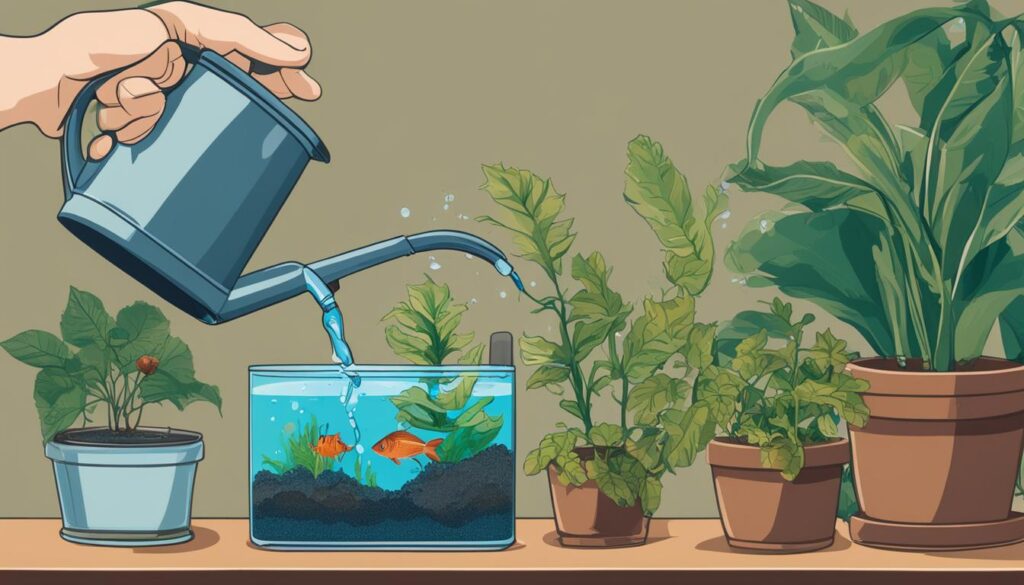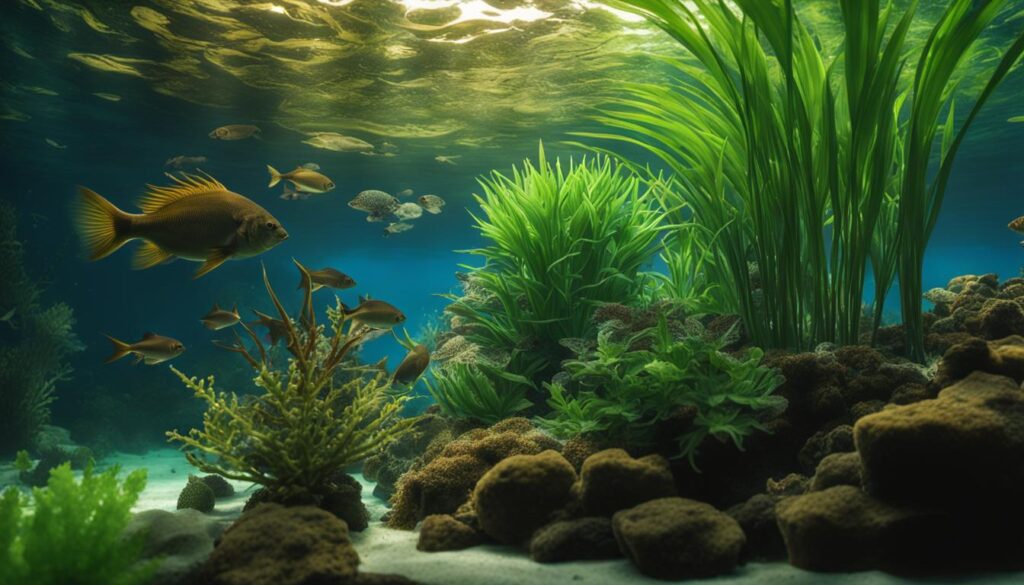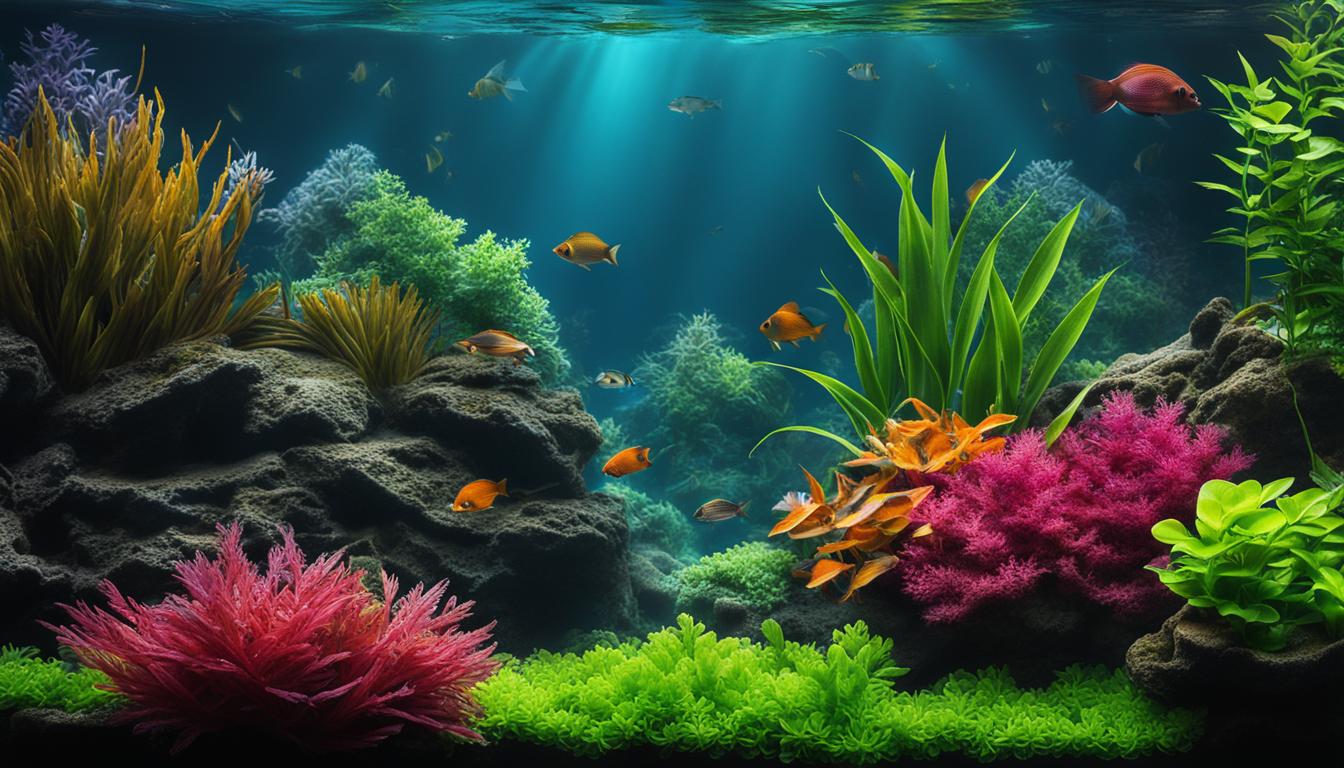Aquarium Plants for Beginners: If you’re new to the aquarium world, you might be wondering how to add some greenery to your underwater oasis without expert skills. Luckily, there are plenty of beginner-friendly options to choose from that will make your tank beautiful without adding extra hassle to your routine. In this guide, I’ll introduce you to easy-care aquarium plants that will bring color, life, and natural filtration to your aquarium.
Table of Contents
Key Takeaways
- Adding aquarium plants can add natural filtration to your aquarium and improve water quality.
- Choosing beginner-friendly plants involves considering factors such as lighting requirements, water parameters, and growth rate.
- There are many easy-to-care-for and low-maintenance options available for beginners.
- Troubleshooting common issues with beginner plants, such as algae growth and nutrient deficiencies, can be resolved with a few simple tricks.
- Don’t be afraid to experiment and expand your plant collection as you gain more experience!
Why Choose Aquarium Plants for Your Underwater Oasis
Are you looking to create a beautiful and thriving underwater oasis? Adding aquarium plants can provide numerous benefits for both your fish and the overall aesthetic of your tank.
First and foremost, aquarium plants can help improve water quality by removing harmful toxins and chemicals through a process called natural filtration. This promotes a healthy environment for your fish to thrive in.
In addition to improving water quality, adding aquarium plants can enhance the visual appeal of your underwater oasis. From vibrant colors to interesting textures, plants can add life and beauty to your tank.
But that’s not all – aquarium plants can also create natural habitats for your fish, providing hiding places and spawning areas. This can help reduce stress and promote a healthy living environment for your aquatic pets.
There are a variety of aquarium plants to choose from, including beginner-friendly options to more advanced species. Selecting the right plants for your specific tank requires careful consideration of factors such as lighting requirements, water parameters, and growth habit.
In the next sections, I will provide you with essential insights and recommendations on how to choose and take care of beginner-friendly aquarium plants, ensuring the healthy and beautiful environment your underwater oasis deserves.
Factors to Consider When Choosing Beginner-Friendly Aquarium Plants
As a beginner, it’s essential to choose the right plants for your aquarium. Here are some factors to consider:
Lighting Requirements
Some plants require more light than others, so it’s essential to select plants that thrive in the lighting conditions in your aquarium. Low-light plants are ideal for beginners as they don’t require intense lighting and are typically easier to maintain. Some examples of low light plants include Java moss, Anubias, and Amazon Sword Plant.
Water Parameters
Water parameters such as temperature, pH level, and water hardness can affect the growth of plants. Therefore, it’s essential to choose plants that can thrive in the water parameters of your aquarium. Anacharis, Java fern, and Hornwort are some beginner-friendly plants that can tolerate a wide range of water parameters.
Growth Rate
Some plants grow rapidly, while others grow slowly. When selecting plants, consider their growth rate and ensure that they are suitable for the size of your tank. Fast-growing plants such as Water Wisteria and Brazilian Pennywort can help to keep your aquarium clean by absorbing excess nutrients and controlling algae growth.
Tip: It’s a good idea to choose plants that are easy to propagate so that you can replace them if they die or if you want to grow more plants in your aquarium.
By considering these factors, you can choose beginner-friendly plants that are easy to care for and that will thrive in your aquarium environment. In the next section, I will discuss some of the top easy-to-care-for plants for beginners.
Top 5 Easy-to-Care-for Aquarium Plants for Beginners
As a beginner, selecting the right aquarium plants can be overwhelming, so I have compiled a list of the top 5 easy-to-care-for options:
| Plant Name | Care Requirements | Growth Habit | Compatibility |
|---|---|---|---|
| Anubias | Low light, low nutrients, attach to decorations or substrate | Slow-growing, compact | Compatible with most fish species |
| Java Fern | Low to medium light, low nutrients, attach to decorations or substrate | Slow-growing, broad leaves | Compatible with most fish species |
| Water Wisteria | Low to high light, supplements of iron, plant in substrate or float on surface | Fast-growing, feathery | Compatible with most fish species |
| Moss Balls | Low to high light, minimal nutrients, roll on substrate or float on surface | Rounded, slow-growing | Compatible with most fish species |
| Cryptocorynes | Low to high light, supplements of iron and potassium, plant in substrate | Slow-growing, varied leaf shapes | Compatible with most fish species |
These plants are perfect for beginners because they don’t require specialized equipment, frequent water changes, or extensive fertilization. They are also relatively hardy and can withstand minor changes to the water parameters.
Adding Life and Color with Beginner Aquarium Plants
If you are looking to add some color and vitality to your aquarium, beginner-friendly plants are an excellent option. These plants come in a variety of shapes, sizes, and colors, making it easy to find the perfect fit for your tank. Not only do they add visual interest to your underwater world, but they also provide natural habitats for your fish to explore and play in.
Colorful Options: Some popular colorful beginner aquarium plants include Anubias nana, Ludwigia repens, and Amazon sword. These plants come in various hues, from deep greens to bright reds and pinks, adding a pop of brightness to your tank.
“Adding a variety of plants to your aquarium can create a more dynamic and interesting environment for your fish.” -Aquarium Enthusiast Magazine
Textured Additions: In addition to adding color, beginner aquarium plants can also provide interesting textures to your tank. Plants like Java fern and Java moss have unique leaf shapes and growth patterns that add depth and dimension to your underwater oasis.
Habitat Creation: Another benefit of adding beginner aquarium plants to your tank is creating natural habitats for your fish. Fish love to hide and explore within planted areas, making it more comfortable and enjoyable for them to live in. Adding plants like Vallisneria or Hornwort can create a natural ecosystem for your aquatic pets.
Overall, beginner aquarium plants are an excellent way to add life and color to your underwater landscape. With so many options to choose from, you can easily find plants that fit your tank’s needs and enhance its beauty. Not only are these plants visually appealing, but they also create a more natural and dynamic environment for your fish to thrive in.
Maintaining a Healthy Aquarium Plant Environment
In order to keep your aquarium plants healthy and vibrant, it’s important to maintain a healthy environment. This involves several key factors, including proper lighting, fertilization, and pruning.
Proper Lighting
Light is critical for the growth and health of your aquarium plants. Ensure that your plants receive adequate lighting, but be careful not to overexpose them, as this can lead to algae growth and other issues. Consider the type of plants you have when selecting your lighting, as different types of plants have different lighting requirements.
Fertilization
Just like any other living organism, aquarium plants require proper nutrients to grow. Fertilization is therefore a crucial aspect of maintaining a healthy plant environment. When fertilizing, be sure to use a product specifically designed for aquarium use and follow the instructions carefully to avoid over-fertilization, which can be harmful to your fish and plants. Remember that dosing requirements may vary based on the plant species and your aquarium’s unique conditions.
Pruning
Regular pruning is essential for maintaining healthy and attractive aquarium plants. Be sure to remove any dead or decaying leaves or stems promptly, as they can release harmful toxins into your aquarium water. Additionally, pruning helps to shape your plants and control their growth, preventing them from overshadowing other plants or impeding the movement of your fish.
Tip: Regular maintenance goes a long way in ensuring a healthy plant environment. Schedule a weekly checkup to inspect your plants and address any issues promptly.
Troubleshooting Common Issues with Beginner Plants

As a beginner aquarium plant owner, you may encounter some common issues despite your best efforts to provide a healthy environment for your aquatic plants. Some of these problems include:
- Algae growth
- Nutrient deficiencies
- Pests, such as snails or planaria
To overcome these issues and keep your beginner plants thriving, I recommend the following troubleshooting tips:
- Test your water parameters regularly to ensure they are within the optimal range for your plants. If your water is high in nitrates or phosphates, this may contribute to algae growth. Consider using a phosphate remover or a water change to bring levels back to the appropriate range.
- If you notice yellowing leaves or stunted growth in your plants, this may indicate a nutrient deficiency. Consider adding a liquid fertilizer or root tabs to provide your plants with the necessary nutrients for healthy growth.
- If you are dealing with pests, such as snails or planaria, consider adding natural predator species to your tank, such as assassin snails or loaches. You can also manually remove the pests using a net or tweezers.
By following these tips and addressing any issues promptly, you can maintain a healthy environment for your beginner plants and enjoy their beauty in your aquarium.
Expanding Your Plant Collection: Beginner-Friendly Aquatic Plants
If you’ve successfully maintained a thriving aquarium with easy-to-care-for plants, it’s time to consider expanding your collection. Adding new beginner-friendly aquatic plants to your tank can not only amplify its beauty, but also benefit the overall health of your aquarium. Here are some options to consider:
| Plant Name | Lighting Requirements | Water Parameters | Growth Rate |
|---|---|---|---|
| Anubias | Low to moderate | Neutral to slightly alkaline pH; soft to moderately hard water | Slow |
| Hornwort | Low to moderate | Wide ranges of pH and hardness; tolerant to various conditions | Fast |
| Java Fern | Low to moderate | Neutral to slightly acidic pH; soft to moderately hard water | Slow |
| Java Moss | Low to moderate | Wide ranges of pH and hardness; tolerant to various conditions | Fast |
| Rotala | High | Neutral to slightly acidic pH; soft water | Fast |
Remember to research the care requirements of any new plants you’re interested in before adding them to your aquarium. It’s important to choose plants that are compatible with your existing tank environment and will thrive under your current care routine.
Low-Maintenance Plants for Aquarium Beginners

For beginner aquarium keepers who may have limited time to dedicate to plant care, low-maintenance options are the way to go. These plants require minimal attention while still adding beauty to the tank.
Anubias nana petite: This is a slow-growing plant that doesn’t need to be planted in the substrate. Instead, anchor it onto rocks or driftwood and watch it thrive. It’s also durable and can handle a wide range of water parameters.
Java moss: This is a hardy and versatile option that can grow in a variety of conditions. It doesn’t require much light and can be attached to rocks or other surfaces. It also adds to the natural feel of your aquarium.
Cryptocoryne wendtii: This plant has beautiful dark green leaves and is low-maintenance. It’s also versatile, as it can thrive in low light and cooler temperatures. It can be planted in the substrate and doesn’t require CO2 injection.
Anacharis: This fast-growing plant is perfect for beginners. It can tolerate a wide range of temperatures and doesn’t require high light or CO2 levels. Plant it in the substrate and watch it grow like a weed!
Amazon sword: This plant is known for its striking appearance and easy care. It prefers moderate lighting and can be planted in the substrate. It can thrive in a variety of water parameters and is a great option for beginners looking to add a pop of color to their aquarium.
Conclusion
Choosing beginner plants for fish tanks is a great way to add natural beauty to your underwater oasis while also improving the overall health of your aquatic environment. By selecting easy-to-care-for plants that meet your fish’s needs, you can create a thriving ecosystem that both you and your fish can enjoy.
In this article, I have discussed the benefits of adding aquarium plants to your fish tank and provided tips for selecting the best beginner-friendly plants to suit your needs. Remember to consider factors like lighting, water parameters, and growth rate when choosing plants, and take steps to maintain a healthy environment through proper lighting and fertilization.
With the information in this guide, you can confidently start your journey into the world of aquarium plants and create a beautiful underwater space that you will love to admire and your fish will love to call home.
FAQ
What type of aquarium plants are best for beginners?
There are several beginner-friendly aquarium plants that are easy to care for. Some popular options include Java Fern, Anubias, and Amazon Sword. These plants are hardy, adaptable, and require minimal maintenance.
How do I choose the right plants for my aquarium?
When selecting aquarium plants, consider factors such as lighting requirements, water parameters, and growth rate. It’s important to choose plants that are compatible with your fish species and that will thrive in your tank’s specific environment.
Do aquarium plants help improve water quality?
Yes, aquarium plants play a crucial role in improving water quality. They absorb nitrates, phosphates, and other pollutants, reducing the risk of algae growth and providing a healthier environment for your fish. They also help create a natural balance in the tank.
How can I maintain a healthy aquarium plant environment?
To maintain a healthy plant environment, it’s important to provide appropriate lighting, ensure proper fertilization, and regularly prune and trim the plants. Regular water testing and maintenance, such as water changes, are also essential for optimal plant growth.
How do I troubleshoot common issues with aquarium plants?
Common issues with aquarium plants include algae growth, nutrient deficiencies, and pests. To troubleshoot these problems, you can adjust lighting, use liquid or root fertilizers, and introduce natural control methods, such as adding algae-eating fish or snails.
What are some low-maintenance plants for beginners?
If you’re looking for low-maintenance plants, consider options like Java Moss, Hornwort, and Water Sprite. These plants require minimal care and can thrive in a wide range of water conditions.
References
Master Breeding Techniques for Angelfish – A Guide for Hobbyists
Mastering Dwarf Puffer Fish Care: A Friendly Guide
Male or Female Betta? How to Tell – Your Ultimate Guide
Complete Guide to Plecostomus Tank Size: Tips and Advice
Simple Guide to Easy-to-Care-for Aquarium Plants
Discover the Diverse Corydoras Catfish Varieties- A Guide
Get to Know Various Types of Algae Eaters
Master Guide: Best Water Parameters for Goldfish Care 2023-24
Mastering Black Ghost Knife Fish Care: A Comprehensive Guide
Optimal pH Levels for Tropical Fish: Essential Aquarium Guide
Discovering Freshwater Snail Species: An In-depth Guide
Expert Tips for Breeding Guppies: Keys to Successful Fishkeeping
Discover Peaceful Community Fish: Your Guide to Calm Aquatics
Ultimate Guide to Live Food for Betta Fish — Healthy Choices
Complete Guide to Your Perfect Cichlid Tank Setup
Your Guide to the Best Substrate for Planted Aquariums
Essential Guide to Discus Fish Care: Help Your Pets Thrive!
Grow Your Own Eden: Beginner-Friendly Aquascaping Plants Guide
Perfect Neon Tetra Tank Mates: Guide to Aquarium Harmony
Product Review of Eheim Classic vs Professional
The Ultimate Guide to Discus Fish Care
What Fish Can Live With Discus?
Ideal pH for Discus Fish | Aquarium Water Guide
How to Sex Discus Fish?: A Simple Guide for Hobbyists
Complete Discus Fish Tank Setup Guide
Can Discus Fish Live With Angelfish? The Complete Guide
Discus Diet Guide: What Do Discus Fish Eat?
Are Discus Fish Hard to Keep? Insights & Tips.
Optimal Discus Fish Water Parameters Guide
Discus Fish Size Guide 2024: How Big Do Discus Fish Get?
Ultimate Million Fish Guppy Care Guide 2024
Simple Guide to Easy-to-Care-for Aquarium Plants
Grow Your Own Eden: Beginner-Friendly Aquascaping Plants Guide
Hornwort Aquarium Plants: The Ultimate Guide to Care and Maintenance
Aquarium Equipment for Beginners: The Complete Checklist
Feeding Your Aquarium Fish: The Complete Guide
Common Beginner Fishkeeping Mistakes and How to Avoid Them!
I am a passionate aquarist with over 30 years of hands-on experience in fishkeeping. My journey began at a young age, collecting fish from the wild and learning through experimentation. Specializing in tropical fish, I bring a deep understanding of the hobby to FishKeepingMadeSimple. The site provides honest, detailed reviews of essential products and accessories to help fellow enthusiasts create the best environments for their fish.










[…] koi fish enthusiasts on a budget, there are plenty of affordable options available that still offer beauty and quality. Here, we will explore different varieties and breeds that provide excellent value for […]
[…] Moss is a top pick for easy aquarium plants for beginners, doing well in low to moderate light. It’s great for new aquarium owners because it’s […]